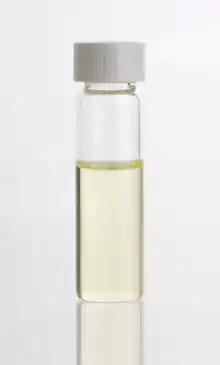
Sandalwood oil is an essential oil obtained from the steam distillation of chips and billets cut from the heartwood of various species of sandalwood trees, mainly Santalum album (Indian sandalwood)[1] and Santalum spicatum (Australian sandalwood).[2]
Sandalwood oil is used in perfumes, cosmetics, sacred unguents, and as a mild food flavouring.[1]
Main constituents
Sandalwood oil contains more than 90% sesquiterpenic alcohols of which 50–60% is the tricyclic α-santalol. β-Santalol comprises 20–25%.[2][3]
The composition of the oil will depend on the species, region grown, age of tree,[2] and possibly the season of harvest and details of the extraction process used.
Current International Organization for Standardization (ISO) standards for S. album oil are 41–55% α-santalol and 16–24% β–santalol (ISO 3518: 2002E).[4]
Traditional uses
Due to its highly coveted fragrance, the essential oil produced from sandalwood is often used in aromatherapy, and is also added to soaps and cosmetics. It is used in Ayurvedic medicine for the treatment of both somatic and mental disorders, including common colds, bronchitis, fever, urinary tract infections, and inflammation.[5] A study investigating the effects of inhalation of East Indian sandalwood oil and its main compound, α-santalol, on human physiological parameters found that the compounds elevated pulse rate, skin conductance, and systolic blood pressure.[5]
There is also religious significance associated with sandalwood oil and it is used in many different religions around the world, including Hinduism, Jainism, Buddhism, and Zoroastrianism.
Production
The oil is distilled from the wood of the entire tree including stump and roots.[6] Australian sandalwood (S. spicatum) is unique in that the white sapwood does not require removal before distilling the oil, while Indian Sandalwood (S. album) does require removal of the sapwood prior to distillation.[7]
Fragrance
Sandalwood oil is used extensively for its woody-floral scent. It pairs well with other wood or floral scents such as violet, rose, tuberose, clove, and oakmoss.[8] But since the wood is so rare and expensive, cosmetic companies are now trying to find synthetic substitutes to try to imitate the structure and scent of sandalwood.
There are several synthetic odorants with odor similar to sandalwood oil, used as lower-cost alternatives for perfumes, emollients, and skin cleaning agents. Common synthetic substitutes include Sandalore, Bacdanlol, Ebanol, Osyrol, and Sandaxol.[9]
Two of these, Sandalore and Brahmanol, have been found to be agonists of the cutaneous olfactory receptor OR2AT4, with potential therapeutic benefits for wound healing. Natural sandalwood oil, and other synthetic sandalwood odorants, did not have the same effect.[10][11]
Safety
There hasn't been extensive research conducted on the safety of sandalwood oil. But because there haven't been any significant adverse effects documented in scientific literature, it continues to be used cosmetically and in food. A few studies were found to identify sandalwood oil's potential toxic effects, but it was determined to be safe at the present levels that the oil is used in food as flavorings.
See also
- Isobornyl cyclohexanol, a synthetic sandalwood oil
- Sandalore, a synthetic sandalwood odorant
- Mysore Sandalwood Oil
References
- 1 2 Kapoor LD (2001). Handbook of Ayurvedic Medicinal Plants. Herbal Reference Library Series. Vol. 2. Boca Raton, Florida: CRC Press. ISBN 978-0-8493-2929-6.
- 1 2 3 "Sandalwood Essential Oil". The Science of Acne. 2015. Archived from the original on 24 February 2015.
- ↑ Krotz A, Helmchen G (1994). "Total Syntheses, Optical Rotations and Fragrance Properties of Sandalwood Constituents: (−)-(Z)- and (−)-(E)-β-Santalol and Their Enantiomers, ent-β-Santalene". Liebigs Ann Chem. 1994 (6): 601–609. doi:10.1002/jlac.199419940610.
- ↑ "Preliminary oil results from a 14-year-old Indian Sandalwood (Santalum album) plantation at Kununurra, WA". Forest Products Commission. 28 March 2006. Archived from the original on 4 March 2016.
- 1 2 Heuberger, E; Hongratanaworakit, T; Buchbauer, G (2006). "East Indian Sandalwood and alpha-santalol odor increase physiological and self-rated arousal in humans". Planta Medica. 72 (9): 792–800. doi:10.1055/s-2006-941544. PMID 16783696.
- ↑ Tony Page; Hanington Tate; Joseph Tungon; Michael Tabi; Phyllis Kamasteia (2012). "Vanuatu sandalwood: growers' guide for sandalwood production in Vanuatu" (PDF). Australian Centre for International Agricultural Research. p. 47. Archived from the original (PDF) on 5 March 2016. Retrieved 9 May 2015.
- ↑ "Frequently Asked Questions". WA Sandalwood Plantations. Retrieved 19 September 2020.
- ↑ Burdock, George A; Carabin, Ioana G (Summer 2007). "Safety assessment of sandalwood oil". Food and Chemical Toxicology. 46 (2): 421–432. doi:10.1016/j.fct.2007.09.092. PMID 17980948.
- ↑ Valiant Candle, Sandalwood Oil: Aromatherapy for Mind, Body, and Spirit, 9 March 2022
- ↑ A Synthetic Sandalwood Odorant Induces Wound-Healing Processes in Human Keratinocytes via the Olfactory Receptor OR2AT4, Daniela Busse1, Philipp Kudella1, Nana-Maria Grüning, Günter Gisselmann1, Sonja Ständer, Thomas Luger, Frank Jacobsen, Lars Steinsträßer, Ralf Paus, Paraskevi Gkogkolou, Markus Böhm, Hanns Hatt and Heike Benecke, Journal of Investigative Dermatology (2014) 134, 2823–2832; doi:10.1038/jid.2014.273; published online 7 August 2014
- ↑ New Scientist magazine, Skin's ability to 'smell' seems to help it heal itself, 8 July 2014